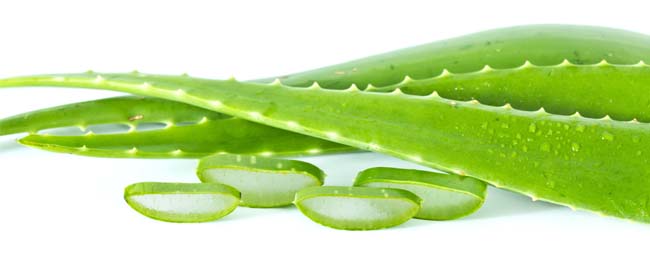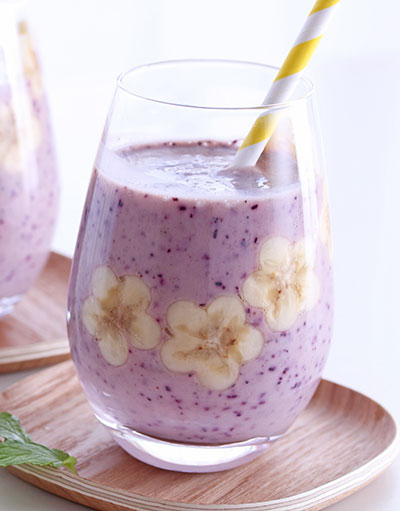When it comes to lotions and potions, nothing says 100% natural like aloe vera. The squishy gel inside the plump leaves has anti-inflammatory and healing properties and can be used at home to treat burns (including sunburn), blisters, insect bites, cuts, rashes, eczema and psoriasis. It also makes a brilliant face mask and hair conditioner (see recipes below).
There’s evidence that aloe vera gel contains enzymes that deactivate bradykinin, the chemical messenger responsible for transmitting pain signals through the nerves. Other compounds include salicylates, which control inflammation and pain, and magnesium lactate, a natural antihistamine. The gel also serves as a stimulant for wound healing, promoting cell and tissue regeneration. It’s able to penetrate injured tissue, relieve pain, reduce inflammation, and dilate capillaries to increase blood supply, which in turn improves healing time. The gel also contains antibacterial and antifungal properties. Pretty amazing stuff.
GROW YOUR OWN ALOE VERA FOR THE MEDICINE AND BEAUTY CABINET
Aloe vera practically thrives on neglect, but it does need a frost-free environment. It performs best in temperatures that remain above 4degC. In cooler areas, grow in pots and shift indoors before winter arrives. Or treat it as an indoor plant, where you have your own herbal first-aid treatment at your fingertips.
Plant in a sunny spot in soil that drains well.
Aloe vera is very easy to propagate. Baby plants form at the base of mature plants; these can be separated and replanted. But let the small plants dry out for a couple of days before potting up.
HOW TO HARVEST
When exposed to oxygen for prolonged periods, the gel oxidises (much as an apple browns when the flesh is exposed to air) and loses its potency. Once cut, use the gel straight away if you can; or within 2-4 hours. Choose a leaf from a plant that’s at least three years old as the active constituents of aloe vera are higher in mature plants.
If you plan to use a large amount of the gel, cut a leaf near the base of the plant. Using a sharp knife, cut down the centre of the leaf, without cutting right the way through, then peel back the two cut edges and scrape out the clear gel. Avoid the greeny-yellow sap next to the rind, as this is an irritant.
If you only require a small amount of gel, just cut off what you need. If you’ve cut a whole leaf from the plant but only use a small amount, snip off what you need from the leaf and wrap the rest in cling film and store in the refrigerator. When it comes to using it again, cut the used end back to the undamaged tissue, then cut off another piece to use.
Aloe vera can be taken internally as a drink, but it’s not recommended for home gardeners to prepare their own. Part of the exudate from a cut leaf contains highly laxative properties and can cause cramps and stomach pains. Stick to the commercial preparations, which have the laxative constituents removed.
ALOE VERA AND HONEY FACE MASK
Aloe vera contains soothing emollients, which help to soften and moisturise the skin. It has a natural pH of about 4.3, which makes it ideal for use on skin, whose pH varies between 4 and 6. You can rub the gel straight onto your skin, or make this luxurious, moisturising face mask.
You need:
Aloe vera leaf
1 egg yolk
1 teaspoon warmed honey
3 teaspoons powdered milk
Using a sharp knife, cut down the centre of the leaf, without cutting right the way through, then peel back the two cut edges. Scrape out the clear gel – you need about 1 teaspoon – and place in a small bowl or cup. Add the egg yolk and honey and beat with a spoon until combined. Add powdered milk to make a spreadable paste, then apply to skin. Leave for 15-30 minutes, then remove with a damp facecloth.
ALOE VERA HAIR CONDITIONER
Aloe vera can be used in place of traditional hair conditioners to make your hair soft and shiny. Simply massage one half to a teaspoon of gel into wet hair (more if you have long, thick hair), let it sit for a couple of minutes then rinse as usual. Or leave it on for 15-30 minutes for a deeper conditioning. Aloe vera is said to promote hair growth by stimulating scalp enzymes, which in turn promotes hair growth, so leaving it in place for 30 minutes is doubly beneficial.
Jane Wrigglesworth
Jane Wrigglesworth edits Herb News, the journal of the Herb Federation of New Zealand Inc, and writes the herb column for NZ Gardener magazine.
 My Favourites
My Favourites










Speak Your Mind